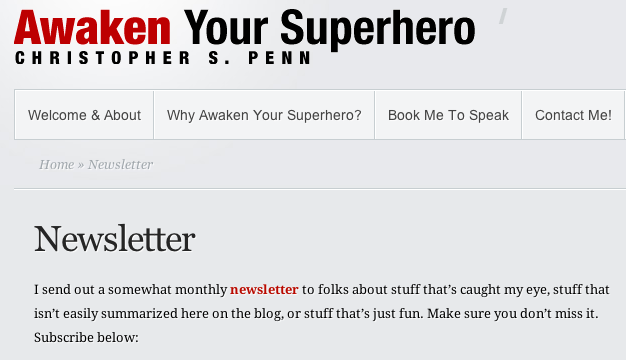This post originally appeared on Voce Communications’ Voce Nation blog.
One of the things that frustrates me most about being in the social media bubble is the fact that we all (social media marketing, PR, and other folks) seem to be each other’s audience; reading each other’s blogs, books, Tweets and newsletters and commenting on them in some great big circle of life (note: a bubble, or if you prefer, fishbowl, is also circular).
I actually think that’s great in many ways; we need and crave each other’s feedback and when done well it makes us all better. When done poorly, it’s just a bunch of industry friends sucking up to each other in public, rubber-stamping content filled with stuff we all already know (reading that back, I make it sound like a bad thing– you decide, but as ever “it depends”). This translates to any person- or company- in any industry.
While many of us strive for “audience” outside of our known colleagues as we build up our businesses or consulting practices, or want to be known more widely as some kind of “wicked smaht” idea machine, we sometimes forget to provide context, wherever possible, to clue in this “audience,” and especially our existing inner circle, that we know who they are and why they read.
More importantly, if you are going to use more intrusive methods like email, you had better make sure you are making yourself welcome in that more personal space. Industry friends occasionally launch email newsletters; while they are generally pretty good, they don’t often tell me anything new, or more importantly, anything I feel I need to know. Worse, many of these email newsletters have a generic feel, treating me as an audience rather than a friend, colleague, acquaintance or peer.
Is that what I am to you? Audience?
Here are my thoughts on making sure your message is received
- Create context: If you are creating something you hope to appeal to a wider audience, acknowledge those closer to you by framing the newsletter with a special message on the version they get. Perhaps it is just a note of hello and thanks; perhaps it is an invitation to give feedback as a trusted colleague; perhaps it is a separate email asking ahead of time if they would like to see the newsletter at all, and what they might like to see in it. You might even create a separate piece of content that appeals to this more sophisticated inner circle.
- Leave people out: Alternatively, just leave people out if you know they won’t need this content– if for some reason you cannot create context, don’t risk your relationships by blasting something out that may not be something they want. Honestly, these folks will not be offended.
- Say something unique: The hardest part of any content is having a unique take– in the social media bubble, we are all talking about the same thing much of the time– what is your niche? What is your unique point of view? We advise clients all the time to differentiate content, and for good reason. In our circle, one example I like very much is Christopher Penn’s. His email newsletter, like his blog, touches on many familiar social media issues, but frames them in a no-nonsense way that does the most difficult thing; speaks to beginners as well as advanced practitioners (even with Chris, to be fair, his World of Warcraft references may not be for everybody). He is also very upfront, not to mention unapologetic, about his distribution methods; you know where you stand with him, and you know why you’re getting his content.
- Expand your horizons: What I mean by this is reach out, find that audience of “outsiders” if that is what you desire. While you can eventually build such an audience by building a reputation and credibility based on a history of solid content, there may be a role for that “inside” group. Rather than foisting the content on them as part of the overall audience, distinguish them as folks not meant for your message, but as equals who, when asked nicely, will forward your content to people they know can use it (I look at the rack of social media books written by folks I know, and remember how often I lend or give out my copies to people better served by the content than I).
Yeah, it comes down to those PR staples many of us have harped on for years upon years: targeting and customizing messages. Is it that simple? No, of course not, but we need to think constantly about how we appear to the people who see our content. different relationships deserve different contexts.


Good post Doug. Being unique isn’t as easy as it sounds, but when done right (Gary Vee, Seth G., Faris Yakob) it is a game changer.
We’d all do well to think as much about how we say things as what we say.
Excellent read, Doug. Especially in light of some recent conversations I’ve seen and/or been engaged in, one involving criticism of The Now Revolution and the other of an enewsletter distributed to a bunch of PR folks announcing another PR pro’s establishment of a “new and entirely different concept – a pr and social media agency” which was really quite annoying to that audience.
Bottom line – we’ve gotten lazy. We don’t often enough step back and think about our marketing messages and who we are directing them to. We don’t filter enough. We don’t respect enough. Using any number of enewsletter programs, you can target your content pretty specifically by using lists. Same is true with Facebook. And you can make it clear on your blog that a post is – or is not – written for all audiences, and like you suggest, you can ask your friends to share the content if if’s not applicable to them.
Consideration. Forethought. Respect. Smart marketing. Understanding the overwhelming amounts of information that we are all bombarded with on a daily basis and trying to thoughtfully and strategically differentiate our messaging isn’t really so hard. You just have to care enough to want to do it.
I love this post. And hope it gets people talking. And, more importantly, changing their behavior.
Shelly
@ShellyKramer
Thanks Rick and Shelly.
I learned a lot when I began Round 2 of PR agency life, as I carved out the freedom to pitch media my own way– I got selective about lists, leaving many folks out – keeping only those I thought would entertain the story idea- and customized how I framed the pitch to those who did get it. I was more successful providing context and editing down than I was in the “blast pitch” days.
Newsletters and other content are no different.